Chung-Wei Hang
Towards Better Understanding Table Instruction Tuning: Decoupling the Effects from Data versus Models
Jan 24, 2025



Abstract:Recent advances in natural language processing have leveraged instruction tuning to enhance Large Language Models (LLMs) for table-related tasks. However, previous works train different base models with different training data, lacking an apples-to-apples comparison across the result table LLMs. To address this, we fine-tune base models from the Mistral, OLMo, and Phi families on existing public training datasets. Our replication achieves performance on par with or surpassing existing table LLMs, establishing new state-of-the-art performance on Hitab, a table question-answering dataset. More importantly, through systematic out-of-domain evaluation, we decouple the contributions of training data and the base model, providing insight into their individual impacts. In addition, we assess the effects of table-specific instruction tuning on general-purpose benchmarks, revealing trade-offs between specialization and generalization.
PRACTIQ: A Practical Conversational Text-to-SQL dataset with Ambiguous and Unanswerable Queries
Oct 14, 2024
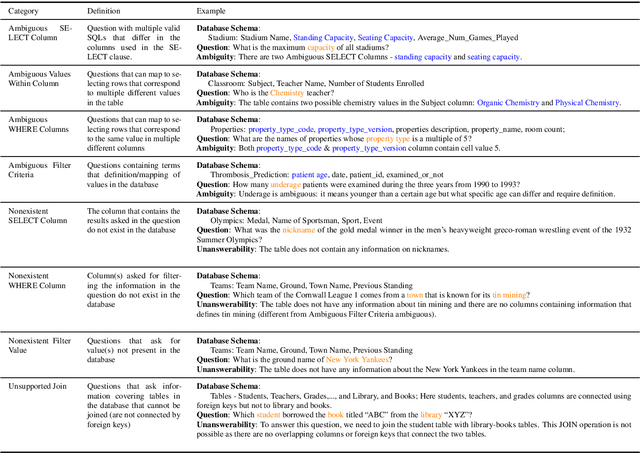
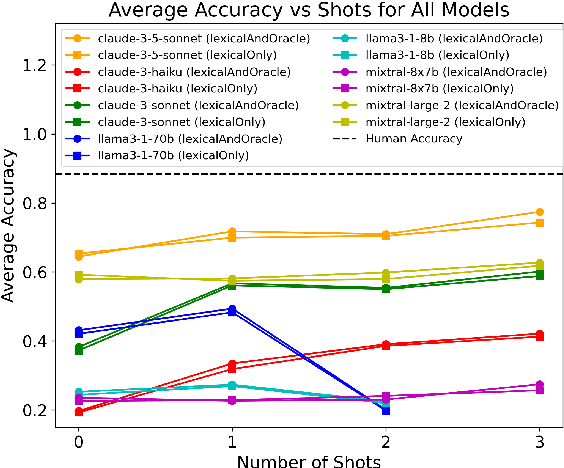
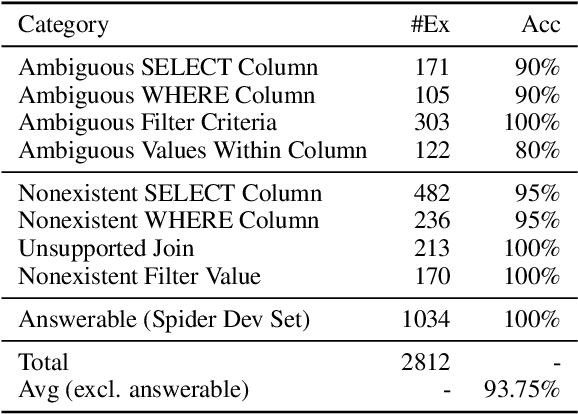
Abstract:Previous text-to-SQL datasets and systems have primarily focused on user questions with clear intentions that can be answered. However, real user questions can often be ambiguous with multiple interpretations or unanswerable due to a lack of relevant data. In this work, we construct a practical conversational text-to-SQL dataset called PRACTIQ, consisting of ambiguous and unanswerable questions inspired by real-world user questions. We first identified four categories of ambiguous questions and four categories of unanswerable questions by studying existing text-to-SQL datasets. Then, we generate conversations with four turns: the initial user question, an assistant response seeking clarification, the user's clarification, and the assistant's clarified SQL response with the natural language explanation of the execution results. For some ambiguous queries, we also directly generate helpful SQL responses, that consider multiple aspects of ambiguity, instead of requesting user clarification. To benchmark the performance on ambiguous, unanswerable, and answerable questions, we implemented large language model (LLM)-based baselines using various LLMs. Our approach involves two steps: question category classification and clarification SQL prediction. Our experiments reveal that state-of-the-art systems struggle to handle ambiguous and unanswerable questions effectively. We will release our code for data generation and experiments on GitHub.
Towards a Holistic Evaluation of LLMs on Factual Knowledge Recall
Apr 24, 2024Abstract:Large language models (LLMs) have shown remarkable performance on a variety of NLP tasks, and are being rapidly adopted in a wide range of use cases. It is therefore of vital importance to holistically evaluate the factuality of their generated outputs, as hallucinations remain a challenging issue. In this work, we focus on assessing LLMs' ability to recall factual knowledge learned from pretraining, and the factors that affect this ability. To that end, we construct FACT-BENCH, a representative benchmark covering 20 domains, 134 property types, 3 answer types, and different knowledge popularity levels. We benchmark 31 models from 10 model families and provide a holistic assessment of their strengths and weaknesses. We observe that instruction-tuning hurts knowledge recall, as pretraining-only models consistently outperform their instruction-tuned counterparts, and positive effects of model scaling, as larger models outperform smaller ones for all model families. However, the best performance from GPT-4 still represents a large gap with the upper-bound. We additionally study the role of in-context exemplars using counterfactual demonstrations, which lead to significant degradation of factual knowledge recall for large models. By further decoupling model known and unknown knowledge, we find the degradation is attributed to exemplars that contradict a model's known knowledge, as well as the number of such exemplars. Lastly, we fine-tune LLaMA-7B in different settings of known and unknown knowledge. In particular, fine-tuning on a model's known knowledge is beneficial, and consistently outperforms fine-tuning on unknown and mixed knowledge. We will make our benchmark publicly available.
Benchmarking Diverse-Modal Entity Linking with Generative Models
May 27, 2023Abstract:Entities can be expressed in diverse formats, such as texts, images, or column names and cell values in tables. While existing entity linking (EL) models work well on per modality configuration, such as text-only EL, visual grounding, or schema linking, it is more challenging to design a unified model for diverse modality configurations. To bring various modality configurations together, we constructed a benchmark for diverse-modal EL (DMEL) from existing EL datasets, covering all three modalities including text, image, and table. To approach the DMEL task, we proposed a generative diverse-modal model (GDMM) following a multimodal-encoder-decoder paradigm. Pre-training \Model with rich corpora builds a solid foundation for DMEL without storing the entire KB for inference. Fine-tuning GDMM builds a stronger DMEL baseline, outperforming state-of-the-art task-specific EL models by 8.51 F1 score on average. Additionally, extensive error analyses are conducted to highlight the challenges of DMEL, facilitating future research on this task.
UNITE: A Unified Benchmark for Text-to-SQL Evaluation
May 26, 2023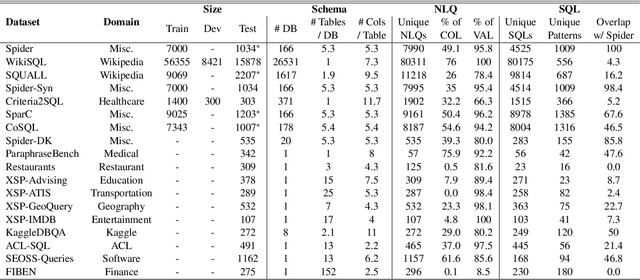
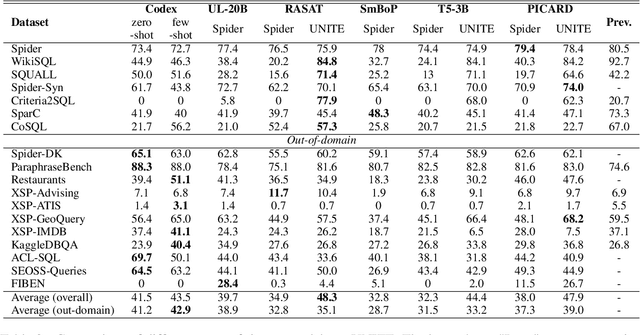
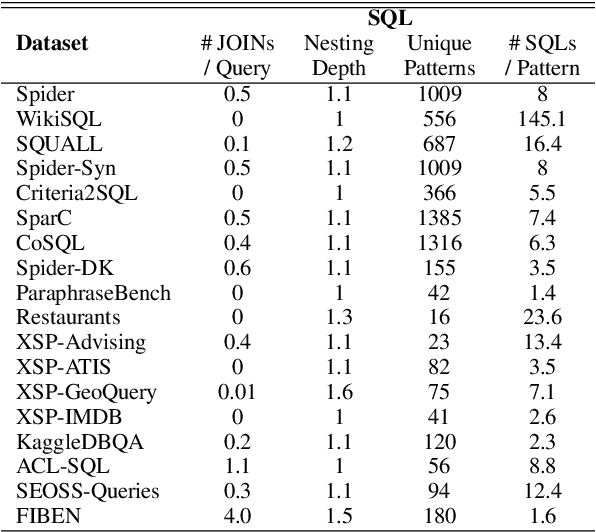
Abstract:A practical text-to-SQL system should generalize well on a wide variety of natural language questions, unseen database schemas, and novel SQL query structures. To comprehensively evaluate text-to-SQL systems, we introduce a \textbf{UNI}fied benchmark for \textbf{T}ext-to-SQL \textbf{E}valuation (UNITE). It is composed of publicly available text-to-SQL datasets, containing natural language questions from more than 12 domains, SQL queries from more than 3.9K patterns, and 29K databases. Compared to the widely used Spider benchmark \cite{yu-etal-2018-spider}, we introduce $\sim$120K additional examples and a threefold increase in SQL patterns, such as comparative and boolean questions. We conduct a systematic study of six state-of-the-art (SOTA) text-to-SQL parsers on our new benchmark and show that: 1) Codex performs surprisingly well on out-of-domain datasets; 2) specially designed decoding methods (e.g. constrained beam search) can improve performance for both in-domain and out-of-domain settings; 3) explicitly modeling the relationship between questions and schemas further improves the Seq2Seq models. More importantly, our benchmark presents key challenges towards compositional generalization and robustness issues -- which these SOTA models cannot address well. \footnote{Our code and data processing script will be available at \url{https://github.com/XXXX.}}
Importance of Synthesizing High-quality Data for Text-to-SQL Parsing
Dec 17, 2022Abstract:Recently, there has been increasing interest in synthesizing data to improve downstream text-to-SQL tasks. In this paper, we first examined the existing synthesized datasets and discovered that state-of-the-art text-to-SQL algorithms did not further improve on popular benchmarks when trained with augmented synthetic data. We observed two shortcomings: illogical synthetic SQL queries from independent column sampling and arbitrary table joins. To address these issues, we propose a novel synthesis framework that incorporates key relationships from schema, imposes strong typing, and conducts schema-distance-weighted column sampling. We also adopt an intermediate representation (IR) for the SQL-to-text task to further improve the quality of the generated natural language questions. When existing powerful semantic parsers are pre-finetuned on our high-quality synthesized data, our experiments show that these models have significant accuracy boosts on popular benchmarks, including new state-of-the-art performance on Spider.
Improved Text Classification via Contrastive Adversarial Training
Jul 21, 2021



Abstract:We propose a simple and general method to regularize the fine-tuning of Transformer-based encoders for text classification tasks. Specifically, during fine-tuning we generate adversarial examples by perturbing the word embeddings of the model and perform contrastive learning on clean and adversarial examples in order to teach the model to learn noise-invariant representations. By training on both clean and adversarial examples along with the additional contrastive objective, we observe consistent improvement over standard fine-tuning on clean examples. On several GLUE benchmark tasks, our fine-tuned BERT Large model outperforms BERT Large baseline by 1.7% on average, and our fine-tuned RoBERTa Large improves over RoBERTa Large baseline by 1.3%. We additionally validate our method in different domains using three intent classification datasets, where our fine-tuned RoBERTa Large outperforms RoBERTa Large baseline by 1-2% on average.
Multilingual BERT Post-Pretraining Alignment
Oct 23, 2020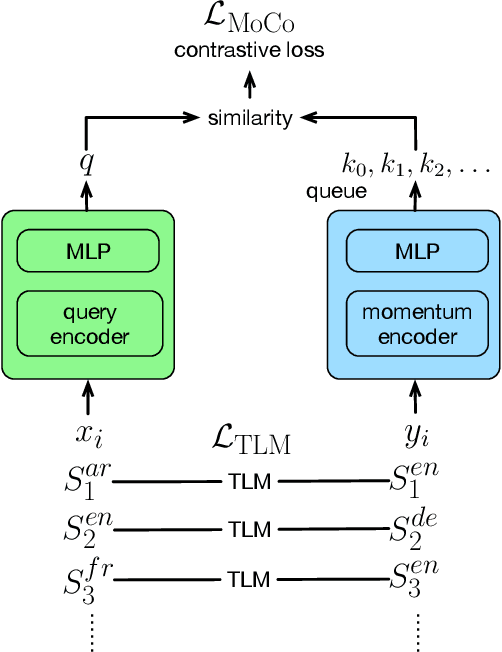
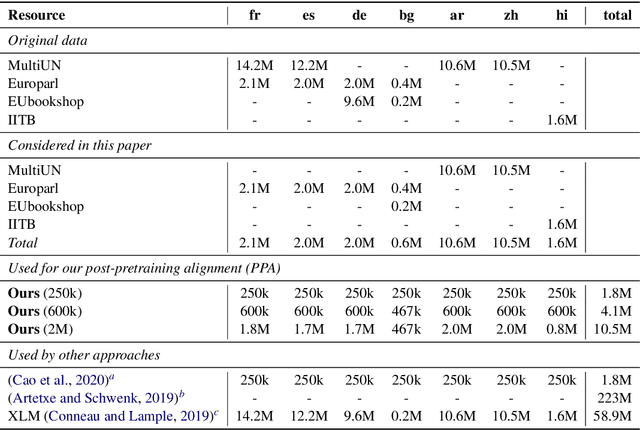
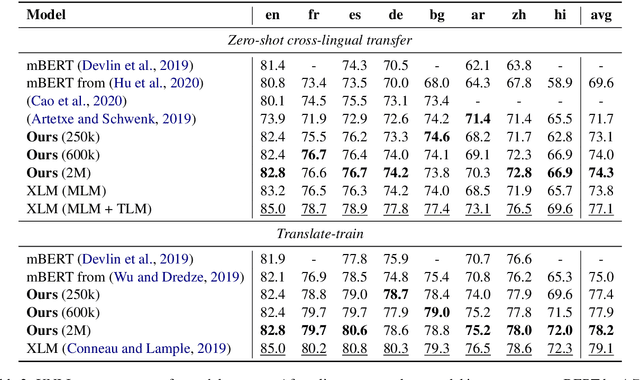

Abstract:We propose a simple method to align multilingual contextual embeddings as a post-pretraining step for improved zero-shot cross-lingual transferability of the pretrained models. Using parallel data, our method aligns embeddings on the word level through the recently proposed Translation Language Modeling objective as well as on the sentence level via contrastive learning and random input shuffling. We also perform code-switching with English when finetuning on downstream tasks. On XNLI, our best model (initialized from mBERT) improves over mBERT by 4.7% in the zero-shot setting and achieves comparable result to XLM for translate-train while using less than 18% of the same parallel data and 31% less model parameters. On MLQA, our model outperforms XLM-R_Base that has 57% more parameters than ours.
Would You Like Sashimi Even If It's Sliced Too Thin? Selective Neural Attention for Aspect Targeted Sentiment Analysis
Apr 27, 2020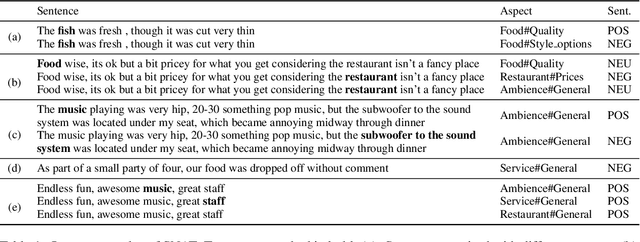
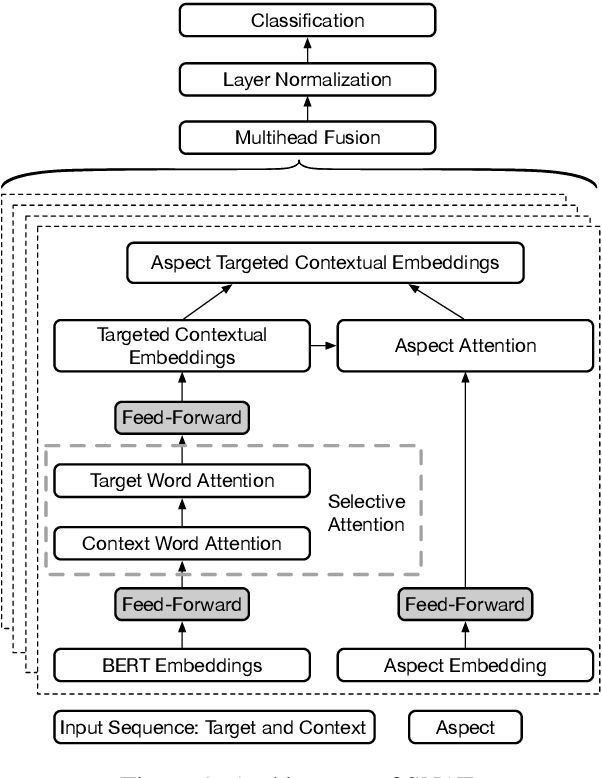
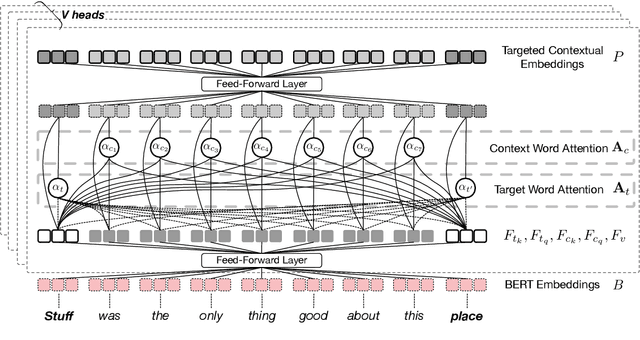
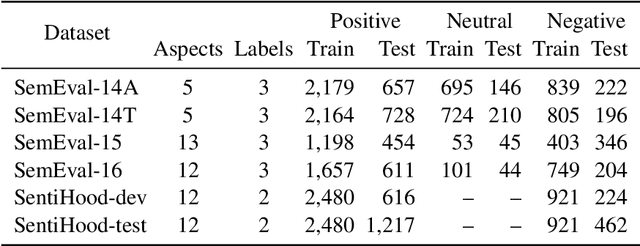
Abstract:Sentiments in opinionated text are often determined by both aspects and target words (or targets). We observe that targets and aspects interrelate in subtle ways, often yielding conflicting sentiments. Thus, a naive aggregation of sentiments from aspects and targets treated separately, as in existing sentiment analysis models, impairs performance. We propose SNAT, an approach that jointly considers aspects and targets when inferring sentiments. To capture and quantify relationships between targets and context words, SNAT uses a selective self-attention mechanism that handles implicit or missing targets. Specifically, SNAT involves two layers of attention mechanisms, respectively, for selective attention between targets and context words and attention over words based on aspects. On benchmark datasets, SNAT outperforms leading models by a large margin, yielding (absolute) gains in accuracy of 1.8% to 5.2%.
Empirical Study on Deep Learning Models for Question Answering
Nov 20, 2015

Abstract:In this paper we explore deep learning models with memory component or attention mechanism for question answering task. We combine and compare three models, Neural Machine Translation, Neural Turing Machine, and Memory Networks for a simulated QA data set. This paper is the first one that uses Neural Machine Translation and Neural Turing Machines for solving QA tasks. Our results suggest that the combination of attention and memory have potential to solve certain QA problem.
 Add to Chrome
Add to Chrome Add to Firefox
Add to Firefox Add to Edge
Add to Edge